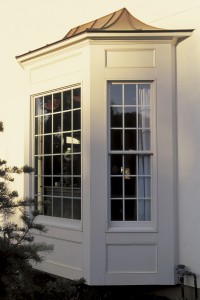 Q: I have an old picture window I want to replace with a bay window. My budget is tight. Which type is best and most efficient? Should I buy an entire unit or assemble one from individual windows?
Q: I have an old picture window I want to replace with a bay window. My budget is tight. Which type is best and most efficient? Should I buy an entire unit or assemble one from individual windows?
Those old, large single-pane picture windows, which were common in houses built many years ago, are extremely inefficient. Not only is there a huge heat loss (and gain, in summer) through the glass itself, but there likely is no insulation around it inside the walls. If one faces south or west, you can count on the drapes, furniture, and carpeting near it to be badly faded.
A bow or bay window is sometimes called the “poor man’s sunroom.” A bow or bay window can actually provide some of the benefits of a sunroom at a lower cost. These include making your room appear larger, providing a seat under glass at the window, and creating an ideal location for plants. Even though it costs considerably less than adding a small sunroom, installing an efficient bow or bay window is still not an inexpensive home-improvement project.
No matter what type of new window design you install in place of the old picture window, it will be more efficient and reduce your utility bills. This savings can help to pay back its initial cost, but it will take many years to pay back the entire cost. By including the utility bills savings with the increase in your home’s resale value, you should be able to recover most of the cost over a reasonable time period.
The basic difference between a bow and a bay window is a bow window is made of four or more narrow window panels, often of the same width. Five windows is the most common configuration. Using more window panels creates a more circular appearance, which many people find attractive. Often, only the two end windows can be opened, but you can order them so they all open. There should be adequate natural ventilation from having only the end panels operable.
Bay windows are made from just three window panels. The two angled side panels usually can be opened and are angled at either 30 or 45 degrees. The fixed center window is similar to a smaller picture window with an unobstructed view of the outdoors. A 45-degree bay window extends further than a 30-degree window from the house wall and provides more space for plants or a bench seat. It creates more of a mini-sunroom feel.
There is not a significant difference in the energy efficiency or durability of a bow or bay window. A bay window may be slightly more efficient because there are fewer joints and seams to be sealed between the window panels. Also, wherever there is framing material and supporting lumber in the wall, there is less room for insulation. Some of the new designs of insulated window glass are more efficient than the existing older house walls.
As with any replacement window style, the glass is the heart of the window. Select the most energy-efficient glass your budget will allow, even if it forces you to cut back on the styling or trim options. At the very minimum, select double-pane glass with a low-emissivity coating and inert gas in the gap between the panes. Make sure to select the proper glass for your area because the location of the low-emissivity coating can vary depending upon your climate. All the new glass types will reduce fading.
Because a bow or bay window protrudes from the wall, it is ideal for natural ventilation during summer to reduce your air-conditioning costs. Casement windows are typically best for standard flat windows because they catch breezes and direct them indoors. With the protrusion of a bow or bay window, double-hung end windows can also be effective for good ventilation.
In addition to high-quality glass, look for a bow or bay window that has insulation, often foam, in the seatboard and the top. This saves energy and improves your comfort near the window. Your plants will also appreciate it during winter.
Unless you are very handy with tools, it is generally better to purchase an entire unit designed as a bow or bay window. This will cost a little more than assembling one from individual windows, but it will likely be stronger and more airtight. Some models use quite sophisticated designs to support the bow or bay window because it is cantilevered out from the wall.
James Dulley is a nationally syndicated engineering consultant based in Cincinnati. If you have a question about energy use or energy-efficient products, send it to: James Dulley, Electric Consumer, 6906 Royalgreen Drive, Cincinnati, OH 45244; or visit www.dulley.com.



